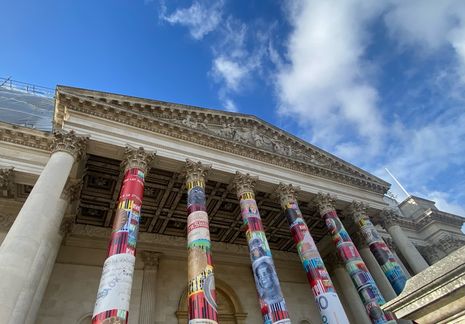‘A bold new move for the Fitzwilliam’: ‘Defaced! Money, Conflict, Protest’ exhibition
For anyone who’s ever wanted to annoy an Economics student by asking them why we can’t just print more money, you must be sure to check this exhibition out.

I’ve been to a fair few Fitzwilliam Museum exhibits in my time, but none as impressive as ‘Defaced! Money, Conflict, Protest’ – the gallery’s newest exhibition this term. By far the most immersive display I’ve seen at the museum, it’s a definite must-see for any art lovers in Cambridge.
Walking along Trumpington Street towards the museum, the exhibit made me stop in my tracks before I had even ventured inside. Garish posters for the exhibition were plastered to the imposing columns of the Fitzwilliam, physically defacing the grand classical architecture of the museum itself (and all the associations of power and wealth). The museum appeared covered with graffiti. It was stamped with the ‘defaced’ symbols of money and power that the building itself appears to represent – the perfect introduction to an exhibition all about protest.
A definite must-see for any art lovers in Cambridge
Naively, I had expected this exhibit to be much like past Fitzwilliam shows I had seen, with the curated artwork somewhat awkwardly intermingling with the Fitzwilliam’s own collection. But this exhibit created a whole new space in the museum, entirely independent from the rest of the gallery.
Stepping inside, it took my eyes a moment to adjust to the concrete; graffiti; scaffolding; and plasterboard— which all vandalised the museum’s white-washed walls. The grungy-looking room had been transformed into a space of resistance, with phrases like "fight fascism" spray-painted across the walls. Cries of "save our NHS" also echoed through the room from a video taken at a protest. It was a nice contrast to the hollow claps of pots and pans we experienced during lockdown.
Moving into the next room, two separate videos were projected onto opposing walls: one depicting an exploding van full of paid-off debt; the other of the organisation behind it, explaining how they helped the financially struggling pay off these high-interest loans. The now-detonated van was impressively hung from the room's ceiling by string. This radical artwork brought this exhibition into a wider social context, representing real-world change.
I think this sense of reality is what I enjoyed most about the exhibit. This 'artwork' wasn’t solely art. It was a material symbol of real-world struggles. Oftentimes this gave the exhibition the joy of feeling more like an immersive history lesson than an art tour.
Much of the exhibition consisted of coins and cash that had been physically marked in some way so that their re-introduction into circulation would spread a message of resistance or rebellion. These commonplace objects no longer just represented an exchange of material goods but an exchange of ideas.
Sometimes, I felt that the use of money as a medium came across as blindly privileged, while at other times it sparked interesting discussions about poverty and power. Some works were made from notes made worthless by hyperinflation. Yet, a highlight of the exhibit was Banksy’s piece that featured £10 notes with Princess Diana’s face embossed over the Queen’s. The art made these tenners worth significantly more than their original value. How can we really place a price on slips of paper and plastic?
This sense of reality is what I enjoyed most about the exhibit
It was also interesting to see these more well-known artists, like Banksy, alongside mostly anonymous works. As the defaced money was often a symbol of rebellion, it was important that some artists kept themselves anonymous. Although at times the endless rows of coins began to grow somewhat monotonous, when you take a moment to look at them closely and read the history behind each piece, their small defacements grow into a fascinating story.
For anyone who’s ever wanted to annoy an Economics student by asking them why we can’t just print more money (or even if you’re the person who’s rolled their eyes and sighed in response!), you must be sure to check this exhibition out. A bold new move for the Fitzwilliam, this exhibition asks brilliant questions about what money is and who gets to control it.
 News / Cambridge academics stand out in King’s 2026 Honours List2 January 2026
News / Cambridge academics stand out in King’s 2026 Honours List2 January 2026 Interviews / You don’t need to peak at Cambridge, says Robin Harding31 December 2025
Interviews / You don’t need to peak at Cambridge, says Robin Harding31 December 2025 Comment / What happened to men at Cambridge?31 December 2025
Comment / What happened to men at Cambridge?31 December 2025 News / AstraZeneca sues for £32 million over faulty construction at Cambridge Campus31 December 2025
News / AstraZeneca sues for £32 million over faulty construction at Cambridge Campus31 December 2025 Features / “It’s a momentary expression of rage”: reforming democracy from Cambridge4 January 2026
Features / “It’s a momentary expression of rage”: reforming democracy from Cambridge4 January 2026









